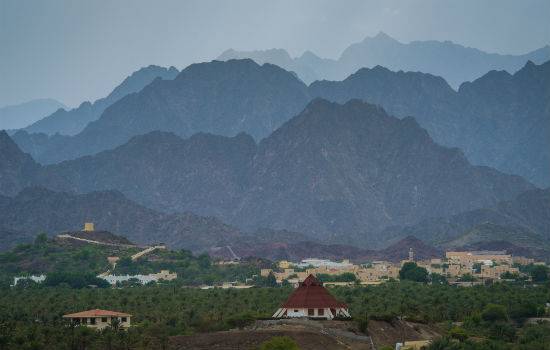
Go back in time to discover the history of Dubai in the nearby mountain town of Hatta. Travel back to an era of citadels, forts and towers in the mountain town of Hatta, dating back several centuries. This quiet retreat, nestled in the craggy peaks of the Hajar Mountains, is known for its ancient Hatta Fort and the remnants of an old village which is still being assessed by historical authorities. The area was once called Al Hajerin or Al Hajeran, in reference to the two mountain peaks guarding its north and south borders, and it makes a spectacular weekend escape.
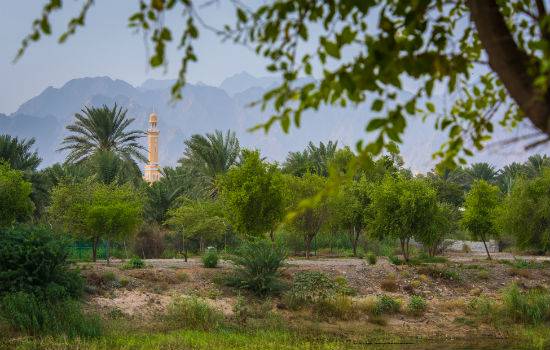
Located nearly 130km south-east of central Dubai, Hatta’s craggy mountain cliffs, scattered springs and lush valleys offer a stark contrast to the glassy facades of the city. Fertile land, favourable climate and a restored falaj, or irrigation system, once allowed for agriculture and farming to thrive. Villagers depended on the cultivation of palm trees, dates and byproducts for their livelihood.
These low-cost, desert-dwelling trees were enough to sustain daily life; dates would be harvested for domestic food needs or dried and sold. Palm leaves were woven into mats, fans and carpets, while tree trunks were used to construct tents and houses.
Farming continues to be a major activity in Hatta and, today, more than 550 farms operate across the nearly 140 square kilometre area, representing 10% of the land. Visitors can see the remnants of this past in small farms within the village, as well as plans for the future in the form of new bird and animal conservation areas.
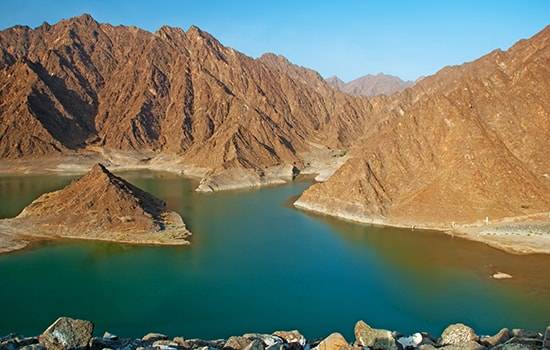
In the past, due to the scarcity of rainwater, residents had to depend on groundwater wells and springs. But following the construction of a number of dams, water is now available all year round in the wadis (valleys) cradled by the mountains. These are replenished by rainwater in winter, which typically breathes new life in the valleys, with flora and fauna emerging spectacularly.
The main Hatta Dam was constructed in the late 1990s, and the reservoir took two years to fill, bringing much-needed respite to Hatta’s residents, who now had access to a sustainable water supply.
Hatta Dam is now one of the main attractions in the area, with the bright, turquoise water set against the earthy rock offering a stunning photo opportunity. Visitors can drive along the dam and stop at viewpoints for photographs, or trek across it and down the hilly terrain.
Flanked by the mountains, Hatta enjoys a cooler climate than its coastal counterparts. The summits of the Hajar mountains reach 800m-1,600m and were first formed under the seabed in ancient times. Their imposing presence includes beautiful rock formations and crevices, sculpted by years of geological activity.

In the heart of the town is Hatta Heritage Village which has been preserved and reconstructed by the government to showcase rural living dating back centuries. Opened in 2001, the village brings to life Dubai’s heritage, with reconstructed traditional huts and buildings selling traditional wares. The village also houses life-size prototypes, documents, and sculptures.
Located within the Heritage Village is the Bait Al Wali, one of the largest houses, where the ruler would reside. It has several rooms, a courtyard and a shaded seating area. Here you’ll see cultural garb, jewellery, weaponry, pottery and utensils, made by villagers using clay, leather and copper, which was mined in the mountains. Visitors are also enlightened about social customs, from marriage to folklore, games to traditional songs. It’s the perfect place to take a family on an afternoon visit.

Also on show is the main Hatta Fort, one of several structures built around the UAE for defence and surveillance purposes, but also formed the centre of public discourse.
Built in 1896, the Hatta Fort is one of the most significant architectural monuments in the UAE. The structure functioned both as a residence and for defence and features a large internal courtyard and an 11m high watchtower. The building, which was restored in 1995, is made of mountain stones and mud bricks, while the ceiling is constructed using palm fronds, trunks and mud.
The two round watchtowers overlooking the mountain village were built in the 1880s. They are located 2.5m above ground level and have a small door and semi-circular staircase leading to the roof. Guards would use ropes to scale the towers and enter through the doors.
The historical area also celebrates key events on the UAE’s national calendar, including National Day, Flag Day and the Dubai Shopping Festival.
A short walk from the village is the palm tree farm known as the Al Sharia site. Here you can take a tranquil walk under the trees and explore the falaj, the ancient irrigation system, which extends several kilometres under ground before appearing on the surface.
Near the village is the Hatta Hill Park, built in 2004. The 63,915 sqkm area is popular for picnics and barbecues, and has a tower, which makes an excellent vantage point. From here, you can take in a bird's-eye view of the Hajar and the villages.
From hiking to biking, there’s much to explore in Hatta.
Craggy mountain peaks, crisp air and an untamed environment make the mountain enclave of Hatta the ideal spot for mountain bikers, adventurers and nature-lovers. From taming the rough terrain on a mountain bike, to tackling the teal waters by kayak, or simply exploring the cultural town by foot, there’s much to do just over an hour away from central Dubai.
Hop onto a mountain bike
There’s possibly no better way to experience the meandering pathways of hills, wadis and farmland than from the back of a mountain bike. Multiple trails for beginner to advanced-level riders have been set up by the Hatta Mountain Bike Trail Centre, an initiative backed by Dubai Municipality. The trails are free to ride and are self-guided with clear markers.
Longtime Dubai resident and mountain-biking enthusiast, Andy Whitaker, visits Hatta almost every weekend for his riding fix. He recommends starting from Dubai before dawn to get the best out of the experience.
“I would head to Hatta from Dubai at 5am, to aim to be riding by 6-6:30am Ride for three hours, then take a dip in one of the pools along the Green trails,” he says. (Note: you can catch the sunrise at this time in the winter months and the pools are seasonal).
Brave visitors can choose to tackle the trails on their own or join the many hobby groups, some of which meet for weekly rides. Give yourself two-three hours for a riding session, with stops to enjoy the lush surroundings.
Hatta is also the centre of a planned packed mountain biking calendar, with endurance challenges, professional races and amateur events.



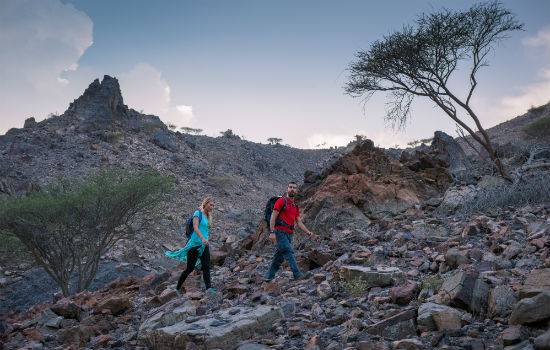
Surrounded by the Hajar Mountains, Hatta is covered in undulating peaks and troughs perfect for hiking. You can trek along the winding wadis at the foothills of the mountains, near the border with Oman. Here you’ll see the varied terrain, from sandy patches to sharp rock.
A popular spot is behind the much-visited Hatta Dam, one of the largest water bodies in Hatta. Behind this you’ll come across rough rock, with stunning vantage points to take in the picturesque landscape, and some wildlife sightings. If you’re lucky you might even spot the elusive Arabian sand cat.
Five official hiking routes have been mapped out and are in the process of being finalised. Advanced trekkers can venture into the rugged mountains for more challenges and some surprises. Before heading out, make sure you have all the right safety gear and equipment, and enough food to sustain you through what can be a strenuous, but thrilling, experience.
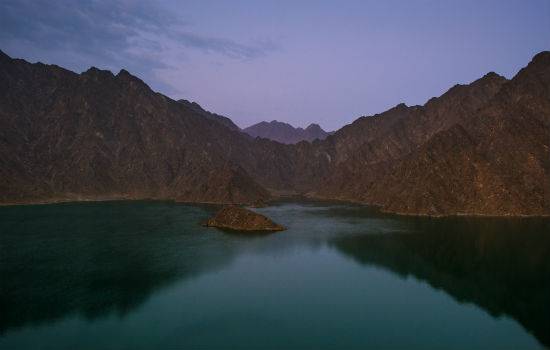
The landscapes of Hatta possess some of the most beautiful natural scenery in the UAE. Enjoy the changing scenes from desert to mountain on your way into Hatta. Once there, head south towards the Hatta Dam, which is an indelible sight: calm turquoise waters set against the rough-hewn mountains.
Another major draw is the Hatta Heritage Village in the central town. This restored museum is an example of true Emirati life in historic times. It comprises 30 buildings, including huts and houses, reconstructed as they were hundreds of years ago. The Village also houses relics and documents of past life, where you’ll learn about Dubai’s Arabian heritage from food to folklore.
Take a tour around the Village and you’ll see two watchtowers and a fort, as well as a mosque from olden times.
Hatta Heritage Village
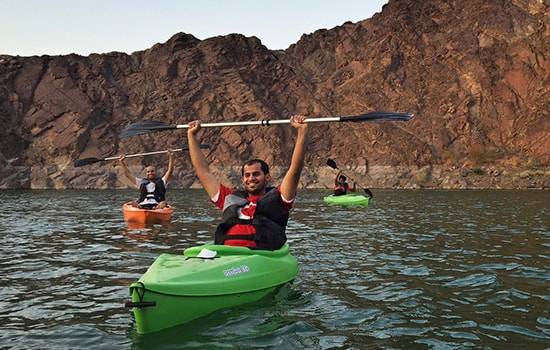
Visitors to Hatta can try something a bit different - kayaking through the vast Hatta lake (Hattakayak.com). Tourists and residents can rent kayaks or paddle boats from a kiosk at the reservoir for a relaxing ride across the clear waters of the turquoise-hued lake, where they’ll encounter natural inhabitants including fish and birds. You can venture into unseen areas through curved passageways hidden behind the mountains and not visible from the reservoir viewpoint.
Whether it’s mountain biking, hiking or camping, Hatta is the ideal destination for thrill-seekers and nature-lovers, check out our must-do listnow.